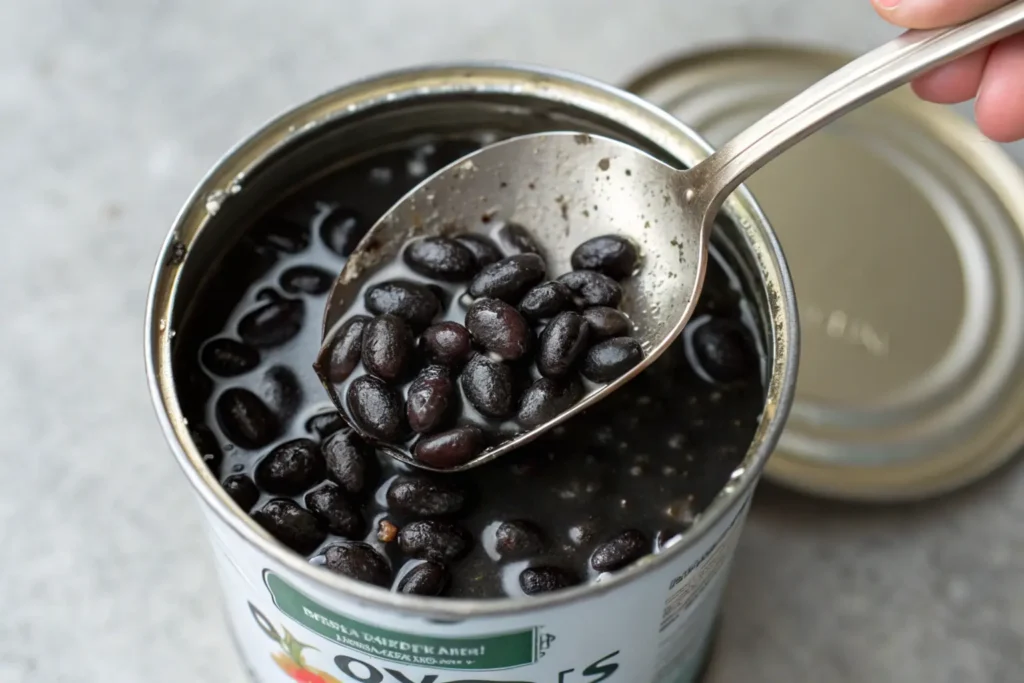Introduction
Goya black bean soup is a popular choice for those seeking a quick, nutritious meal. However, some consumers may notice a white or grayish substance floating in the soup or sticking to the beans. This visual anomaly often sparks concern, especially when it comes to food safety. Understanding the origin and composition of this residue can alleviate many misconceptions. Canned black beans, like those in Goya’s products, contain natural components that may behave differently under certain conditions. Moreover, proper handling and storage play a significant role in maintaining the beans’ appearance and quality. In this article, we explore the reasons behind this mysterious white substance, its safety, and its impact on overall product quality. By breaking down the science and addressing common concerns, we aim to provide clarity and confidence for those enjoying Goya black bean soup.
Understanding the White Residue in Goya Black Bean Soup
The white residue in Goya black bean soup is primarily made up of natural starches and proteins released from the beans during cooking and canning. These components may settle on the beans or appear as cloudy, foamy material. This process occurs naturally and does not indicate spoilage or contamination. For more insights into how to manage such visual changes in similar soups, check out How to Get Rid of Bitter Taste in Black Bean Soup.
Common Concerns About Canned Beans Appearance
Many consumers worry about visual irregularities in their food, particularly when it comes to canned products. One of the most frequent questions is, what is the white stuff in Goya black bean soup? This concern stems from the fear that the residue might indicate spoilage, contamination, or improper processing. However, most changes in canned beans are harmless and natural. Residues or foamy substances often result from the combination of starch and bean proteins during the canning process. Factors like temperature, storage conditions, and natural components in the beans can also influence their appearance. In most cases, these visual differences do not impact the beans’ safety or flavor. To address this concern, it is essential to learn the common causes behind such appearances and when to take action. Understanding these factors will reassure consumers about the safety of their Goya black bean soup.
What Is the White or Grayish Substance?

When asking what is the white stuff in Goya black bean soup?, it is important to note that the white or grayish substance is typically harmless. It often consists of natural starches and proteins released from the beans during the cooking and canning processes. These substances may settle on the beans or appear as cloudy liquid. Over time, the starch and protein particles may form visible residues that float in the soup. In some cases, slight discoloration or residue can also result from temperature fluctuations during storage or transportation. Importantly, this substance is not mold or a sign of spoilage when the can remains sealed and undamaged. Recognizing that the white material is a natural byproduct of the beans can alleviate concerns. However, it is essential to know when this residue might indicate spoilage, which will be discussed further in the article.
How Starch and Foam Form in Canned Black Beans
Foam and starch deposits are common occurrences in canned black beans, particularly in products like Goya black bean soup. Beans are naturally rich in starch, which thickens the cooking liquid during preparation. When the beans are heated, their starch content is released into the surrounding water. This process creates a thick, sometimes foamy liquid that may leave a white residue on the beans. In Goya black bean soup, this residue is entirely natural and occurs due to the product’s simplicity and minimal additives. Foam formation can also happen when air bubbles become trapped during the canning process. These bubbles may dissipate when the can is opened, leaving behind visible starch particles. While this process may seem unusual, it does not compromise the beans’ safety or nutritional value. Consumers can simply rinse the beans if they prefer a cleaner appearance.
Can Warmer Weather Impact the Appearance of Beans?
External factors, such as temperature changes, can affect the appearance of canned black beans. For example, during warmer weather, starches and proteins within the beans may expand and shift. This can sometimes lead to the formation of a white or grayish substance in Goya black bean soup. Additionally, fluctuations in temperature during transportation or storage may alter the texture of the cooking liquid. Higher temperatures can cause starches to separate more visibly from the beans, making them appear cloudier. While these changes might seem concerning, they are generally harmless and do not impact food safety. Proper storage of canned beans in cool, dry environments can help minimize these effects. Consumers who store their Goya black bean soup in warmer areas may notice these visual changes more often. Understanding this phenomenon can help prevent unnecessary worries about the product’s safety or quality.
- When the beans are heated, starch content is released into the surrounding water. If you’re cooking dried black beans at home and wondering whether soaking is necessary, read more on do you need to soak black beans before making soup for helpful tips.
The Science Behind the White Residue
Understanding the white residue in Goya black bean soup requires examining the natural processes occurring within canned beans. When consumers ask, “What is the white stuff in Goya black bean soup?”, the explanation often relates to starch and proteins. These components naturally exist in black beans and are released into the cooking liquid during preparation. Once the canning process is complete, the liquid surrounding the beans may thicken, leading to occasional residue. Additionally, the interaction between heat, water, and bean components during canning causes starch to form visible particles. These changes are entirely normal and occur with many other canned legumes. To provide reassurance, it is crucial to recognize that these residues are not harmful. Instead, they are simply a byproduct of the natural makeup of black beans combined with the preservation process. Next, we explore starch’s role in more detail.
Starch and Its Role in Black Beans
Starch is a significant component in black beans and plays a key role in the texture and consistency of Goya black bean soup. When beans are cooked, starch granules absorb water and swell, softening the beans while thickening the surrounding liquid. This process creates the familiar hearty texture found in canned black beans. However, this natural process also answers the question, “What is the white stuff in Goya black bean soup?” During storage, the starch can settle on the beans or appear as cloudy liquid, forming a harmless white residue. The presence of starch is a good indicator of the beans’ natural quality, as it signifies minimal additives or processing. When rinsing canned beans, the white starch residue often washes away, leaving the beans clean for use. Understanding this interaction highlights why the white substance is both natural and safe.
How Natural Processes Affect Bean Liquids
The natural breakdown of black beans during cooking and canning significantly influences the appearance of their liquids. Consumers curious about “What is the white stuff in Goya black bean soup?” often notice this residue as part of the thickened or cloudy liquid surrounding the beans. Black beans release natural starch, proteins, and small amounts of fiber during the cooking process. Over time, these components may separate or settle, forming visible particles or residue. Temperature, storage duration, and handling further contribute to this change, as these factors can cause starch molecules to cluster. Importantly, these processes are entirely normal and occur in any naturally processed legumes. The consistency and appearance of the liquid may vary from can to can, but these variations do not affect the safety of the product. Properly understanding these processes helps reduce unnecessary concerns about the soup’s quality.
Bacterial Safety Concerns in Canned Foods
When asking, “What is the white stuff in Goya black bean soup?”, some may worry about bacterial contamination or spoilage. However, canned foods undergo strict safety measures to ensure bacteria cannot thrive. During the canning process, black beans are heated to high temperatures, effectively eliminating harmful microorganisms. The can is then sealed in an airtight environment to prevent bacterial growth. As a result, the white residue commonly seen in Goya black bean soup is not a sign of contamination. It is instead a natural byproduct of the beans’ starch and proteins. That said, consumers should always inspect cans for damage, swelling, or leaks, as these signs may indicate spoilage. A clean, intact can guarantees that its contents remain safe for consumption. This process reinforces the safety and reliability of Goya black bean products.
Is the White Stuff Safe to Eat?
Many consumers wonder, “What is the white stuff in Goya black bean soup, and is it safe to eat?” The short answer is yes. The white or grayish residue found in canned black beans is typically harmless. It primarily consists of natural starch, proteins, and other components released from the beans during cooking and storage. These substances may look unusual but pose no health risks. In fact, their presence often indicates that the beans have undergone minimal processing. While some people prefer to rinse the beans to remove the residue, others simply stir the liquid back in, as it does not affect the taste or safety of the product. Understanding that this white substance is a natural byproduct can provide peace of mind for consumers who enjoy Goya black bean soup as part of their meals.
Insights from Goya on Bean Safety
Goya Foods maintains high standards when it comes to the safety and quality of their canned black bean soup. In response to questions like “What is the white stuff in Goya black bean soup?”, Goya has clarified that the residue is a natural result of the cooking and canning process. Beans contain natural starches and proteins, which may appear as residue in the liquid over time. Goya’s canning process ensures that these products remain safe, nutritious, and free of harmful bacteria. Regular quality control checks are conducted to ensure consistency and safety across all products. Consumers can trust that Goya black bean soup meets food safety regulations and quality standards. By understanding this, consumers can feel confident in including Goya products in their meals without unnecessary concerns about appearance.
Nutritional Value of Goya Black Beans
Goya black bean soup is not only safe but also highly nutritious. Despite the presence of natural residues, the beans retain their rich nutritional content, including fiber, protein, vitamins, and minerals. This makes them a valuable addition to a balanced diet. For those asking, “What is the white stuff in Goya black bean soup?”, it is reassuring to know that the residue does not affect the nutritional value. Black beans are known for promoting digestive health, stabilizing blood sugar, and providing sustained energy. The cooking liquid, which sometimes contains the white residue, also holds nutrients leached from the beans. Rinsing the beans may remove some of the starch but does not significantly impact their nutritional benefits. Overall, Goya black bean soup remains a wholesome, flavorful, and nutrient-packed choice for consumers.
When to Avoid Canned Beans: Signs of Spoilage
While the white residue in Goya black bean soup is natural, it is essential to recognize signs of actual spoilage. Consumers often ask, “What is the white stuff in Goya black bean soup, and when should I be concerned?” Spoiled canned beans exhibit clear warning signs, including:
- Bulging or dented cans, which may indicate bacterial contamination.
- Leaks or rust on the can’s exterior, compromising food safety.
- An off-putting smell when the can is opened.
- Discoloration or mold-like growth, which is distinct from natural residue.
If any of these signs are present, the beans should not be consumed. It is always best to inspect the can before use and store it in a cool, dry place to prevent spoilage. Recognizing the difference between harmless residue and actual spoilage ensures that consumers can safely enjoy Goya black bean soup without worry.
Consumer Experiences with Goya Black Bean Soup
Many consumers have shared concerns and experiences about the appearance of their Goya black bean soup. Specifically, they often ask, “What is the white stuff in Goya black bean soup?” It is common for people to mistake the harmless starch residue for mold or spoilage. However, this natural white or grayish material forms due to starch released from the beans during processing. Some consumers have reported that rinsing the beans or stirring the liquid can help reduce its visibility. Others mention that the residue does not affect the soup’s flavor or texture, making it entirely safe to enjoy. Overall, understanding the cause of the white residue helps consumers appreciate the natural and minimally processed quality of Goya black bean soup without unnecessary concern.
Common Complaints About White Residue
When asking, “What is the white stuff in Goya black bean soup?”, some consumers express initial concern about its appearance. The residue can sometimes look unfamiliar, especially if consumers are accustomed to completely clear liquids in canned beans. However, this white or grayish material is not a defect or spoilage. It forms naturally when starch and proteins are released from the beans during cooking. While the appearance may differ from batch to batch, Goya assures consumers that their products meet strict safety and quality standards. For those who find the residue unappealing, rinsing the beans under water can minimize its presence. It is important to recognize that these visual differences do not affect the taste, safety, or overall quality of Goya black bean soup.
Does the Residue Affect Taste and Texture?
The white residue seen in Goya black bean soup does not significantly impact the product’s taste or texture. While some consumers may notice a thicker consistency in the cooking liquid, this results from the natural starches released by the beans. The soup retains its rich, earthy flavor and smooth texture, even when the white residue is present. When asking, “What is the white stuff in Goya black bean soup?”, it is reassuring to know that this residue does not compromise the product’s quality. For those who prefer a cleaner appearance, rinsing the beans can remove most of the visible starch. However, keeping the liquid adds flavor and nutrients, enhancing the overall meal experience.
While the white residue is natural, it’s essential to recognize spoilage signs, like bulging cans, leaks, or an off-putting smell. For more tips on preparing canned beans and ensuring food quality, you may find Do You Need to Soak Black Beans Before Making Soup? helpful.
FAQs
What is the white stuff in my can of black beans?
The white substance in your can of black beans is primarily starch and proteins released naturally during cooking and canning. It is harmless and a natural byproduct of the beans.
What is the white stuff in my soup?
The white stuff in your soup comes from starches and proteins within the beans. These components may settle or separate, forming a visible residue that is completely safe to eat.
Why do my beans have white stuff?
The white material on your beans forms when starches and proteins combine with water during cooking. It is normal for canned beans and is not a sign of spoilage.
What happens if you don’t rinse canned black beans?
If you don’t rinse canned black beans, you may retain the cooking liquid, which contains natural starch and some sodium. This liquid can add flavor and nutrients to your dish.
Conclusion
In summary, the answer to “What is the white stuff in Goya black bean soup?” lies in the natural starches and proteins released during cooking and canning. This residue may appear as a white or grayish substance, but it is entirely harmless and does not affect the soup’s quality or safety. Goya black bean soup remains a nutritious, flavorful, and convenient option for consumers. By understanding the cause and nature of this residue, consumers can enjoy their meals with confidence. Proper storage, rinsing the beans if desired, and recognizing signs of spoilage ensure a worry-free experience. Ultimately, Goya black bean soup delivers consistent quality, making it a trusted choice for households worldwide.


1 thought on “What Is the White Stuff in Goya Black Bean Soup?”